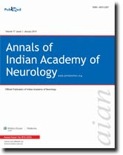
EPILEPSY & BEHAVIOR
Scope & Guideline
Illuminating the complexities of epilepsy and behavior.
Introduction
Aims and Scopes
- Clinical Management of Epilepsy:
Research focusing on various treatment modalities, including pharmacological interventions, surgical options, and non-pharmacological approaches such as dietary therapies and psychotherapy. - Psychosocial Aspects of Epilepsy:
Exploration of the psychological, social, and emotional impacts of living with epilepsy, including stigma, mental health comorbidities, and caregiver burden. - Innovative Technologies and Approaches:
Investigation into the use of technology in epilepsy management, including remote monitoring, telemedicine, and the development of mobile health applications. - Neurobiological and Genetic Insights:
Studies addressing the neurobiological underpinnings of epilepsy, genetic factors, and their implications for treatment and understanding of the disease. - Public Health and Epidemiology:
Research examining the prevalence, healthcare access, and disparities related to epilepsy, with a focus on improving public health outcomes.
Trending and Emerging
- Telemedicine and Remote Care:
The COVID-19 pandemic has accelerated the adoption of telemedicine, leading to increased research on its efficacy and implementation for managing epilepsy, including remote patient monitoring and consultations. - Mental Health Integration:
There is a growing emphasis on understanding and addressing mental health comorbidities associated with epilepsy, including anxiety and depression, and integrating mental health care into overall epilepsy management. - Patient-Centered Care and Self-Management:
Research focusing on empowering patients through self-management strategies, including educational interventions and the development of mobile health applications to improve adherence and quality of life. - Genetic and Biomarker Studies:
An increasing number of studies are exploring genetic factors, biomarkers, and precision medicine approaches that can lead to more targeted therapies and individualized treatment plans for epilepsy patients. - Comorbidities and Quality of Life:
There is an emerging trend in examining the impact of epilepsy on overall quality of life, including the interplay between physical, psychological, and social factors, and how they influence patient outcomes.
Declining or Waning
- Traditional Pharmacotherapy:
Research specifically centered on older antiseizure medications and their applications has decreased as newer treatments and personalized medicine approaches gain attention. - Generalized Epilepsy Types:
There appears to be a waning interest in studies focusing exclusively on generalized epilepsy types, as the field shifts towards more nuanced and individualized understandings of epilepsy. - Animal Models of Epilepsy:
While still relevant, the volume of studies utilizing traditional animal models for epilepsy research has seen a decline as researchers seek more translational approaches that can better inform human studies.
Similar Journals

Epilepsi
Innovating treatment and understanding of epilepsy.Epilepsi is an esteemed academic journal dedicated to advancing the field of epilepsy research and treatment, published by KARE PUBL. With its open access model established since 2017, the journal ensures that vital research findings are easily accessible to a global audience, thereby fostering collaboration and knowledge sharing among researchers, healthcare professionals, and students. The journal focuses on a comprehensive range of topics within neurology, including clinical studies, therapeutic advancements, and innovative approaches to epilepsy management. Located in Istanbul, Turkey, Epilepsi aims to bridge the gap between research and practice, enhancing understanding and patient care for individuals affected by epilepsy. Its commitment to high-quality, peer-reviewed content makes it a significant resource for anyone involved in epilepsy research or clinical practice.

CANADIAN JOURNAL OF NEUROLOGICAL SCIENCES
Empowering Research in Neurology and BeyondCanadian Journal of Neurological Sciences, published by Cambridge University Press, stands as a reputable source of knowledge in the field of neurology, dedicated to advancing research and clinical practice. With an ISSN of 0317-1671 and an E-ISSN of 2057-0155, this journal has been a cornerstone for the exchange of ideas since its inception in 1974 and will continue to cater to the academic community until 2024. Recognized in the top quartile (Q2) in various categories including Medicine (miscellaneous) and Neurology (clinical), its articles engage a broad audience, ranging from established researchers to students seeking to deepen their understanding of neurological sciences. Although the journal is not an open-access publication, it provides vital insights and research findings that contribute significantly to its fields. With a Scopus rank of #183 in clinical neurology and a percentile ranking that reflects its commendable standing, the Canadian Journal of Neurological Sciences is indispensable for those committed to the exploration and treatment of neurological disorders.

EPILEPSIA
Transforming research into clinical excellence.EPILEPSIA is a premier academic journal published by Wiley, with a storied history dating back to 1909, making it a cornerstone in the field of epilepsy research and neurology. With an impressive impact factor reflecting its robust contribution to the academic community, EPILEPSIA is categorized in the top quartile (Q1) in both neurology and clinical neurology as of 2023, underscoring its significance and prestige. The journal is ranked #15 out of 192 in Neuroscience & Neurology and #34 out of 400 in Medicine & Neurology (clinical) within Scopus, indicating its essential role in advancing knowledge and treatments related to epilepsy. Researchers and clinicians are encouraged to contribute groundbreaking studies, case reports, and reviews that inform best practices and improve patient outcomes. Although EPILEPSIA currently does not offer open access options, its detailed exploration of both fundamental and clinical aspects of epilepsy ensures wide dissemination of crucial findings among professionals and students alike, furthering the understanding and management of this complex condition.

Annals of Indian Academy of Neurology
Elevating Standards in Neurological ResearchAnnals of Indian Academy of Neurology is a premier open access journal dedicated to advancing the field of Neurology, serving as a vital resource for researchers, healthcare professionals, and students since its inception in 2006. Published by the esteemed Wolters Kluwer Medknow Publications, this journal has established itself within the academic community, boasting a Q3 quartile ranking in clinical neurology according to the 2023 category quartiles and a Scopus rank placing it in the 35th percentile among 400 comparable journals. With a focus on clinical advancements and research innovations in neurology, the journal aims to disseminate high-quality and impactful studies that address the complex challenges faced in the neurological landscape, particularly within the Indian context. The open access model ensures that the latest research is readily accessible to a global audience, thereby promoting collaboration and knowledge sharing within the neurosciences.

Journal of Pediatric Neuropsychology
Bridging research and clinical practice for young minds.Journal of Pediatric Neuropsychology is a pioneering academic journal dedicated to advancing the field of pediatric neuropsychology. Published by SpringerNature, this journal serves as a vital platform for researchers, clinicians, and students aiming to explore the complexities of neuropsychological development in children. With ISSN 2199-2681 and E-ISSN 2199-2673, the journal focuses on a broad spectrum of topics including cognitive processes, neurological disorders, and the impact of neuropsychology on educational and therapeutic practices. Though currently not listed as an Open Access journal, it aims to disseminate knowledge that influences clinical practices and supports interdisciplinary collaboration. The Journal of Pediatric Neuropsychology stands out for its commitment to enhancing understanding within this specialized field, making it an essential resource for professionals and researchers dedicated to improving outcomes for children with neuropsychological challenges.

Egyptian Journal of Neurology Psychiatry and Neurosurgery
Exploring Breakthroughs in Neurosurgery and Mental HealthEgyptian Journal of Neurology Psychiatry and Neurosurgery, published by Springer, is a premier open-access journal that has been dedicated to advancing the fields of neurology, psychiatry, and neurosurgery since its inception in 2009. With an E-ISSN of 1687-8329, this journal aims to provide a dynamic platform for researchers and clinicians to disseminate their findings, fostering a rich dialogue on the latest developments and innovations within these critical disciplines. With an impactful open-access model adopted since 2018, the journal attracts a global audience, facilitating the exchange of knowledge and ideas across various medical and scientific landscapes. In the 2023 rankings, it holds impressive positions within the Q3 category for Neurology (clinical), Psychiatry and Mental Health, and Surgery, as well as Q4 in Miscellaneous Neuroscience, highlighting its value within the field. As a valuable resource for both budding scholars and seasoned professionals, the Egyptian Journal of Neurology Psychiatry and Neurosurgery offers insights that drive progress in the treatment and understanding of neurological and psychiatric conditions.

REVISTA DE NEUROLOGIA
Unveiling Insights in Neurological ScienceREVISTA DE NEUROLOGIA is a distinguished academic journal focusing on the broad fields of neurology and medicine, published in Spain since its inception in 1959. The journal plays a vital role in disseminating significant research findings, clinical studies, and advancements in neurological science, catering to an audience of researchers, clinicians, and students alike. With an ISSN of 0210-0010 and an E-ISSN of 1576-6578, this quarterly publication has maintained its commitment to enhancing the understanding of neurological disorders and therapies through rigorous peer-reviewed articles. While currently not classified as open access, it is indexed in Scopus, holding a rank of #253 out of 400 in the category of Medicine (Neurology), reflecting its relevance in the field with a 36th percentile. The journal is positioned within the Q3 quartile for both Medicine (miscellaneous) and Clinical Neurology categories as of 2023. Based in Barcelona, Spain, it is a vital resource for anyone devoted to the advancement of knowledge and practice in neurology.

EUROPEAN JOURNAL OF PAEDIATRIC NEUROLOGY
Shaping the future of pediatric neurological care.European Journal of Paediatric Neurology, published by Elsevier Science Ltd, is a premier academic journal dedicated to advancing the field of paediatric neurology. With its ISSN 1090-3798 and E-ISSN 1532-2130, this journal serves as a vital resource for researchers, clinicians, and students alike, focusing on the latest findings and innovative treatments in paediatric neurological disorders. The journal has established itself as a leading publication in its field, achieving a Q1 classification in Pediatrics, Perinatology and Child Health, and holding a reputable Q2 status in Clinical Neurology as of 2023. Positioned within the top 88th percentile in Pediatrics and the 76th percentile in Clinical Neurology according to Scopus ranks, it publishes rigorous peer-reviewed articles that contribute significantly to clinical practice and research. Although not open access, the journal provides vital insights into the complexities of neurological conditions affecting the pediatric population, making it an essential tool for scholars and professionals striving to improve child health outcomes. With a publication trajectory spanning from 1997 to 2024, it continues to be at the forefront of paediatric neurological research, inspiring innovation and collaboration in the scientific community.

Current Journal of Neurology
Advancing neurology through open dialogue.Current Journal of Neurology, published by Tehran University of Medical Sciences, is an esteemed Open Access journal dedicated to advancing the field of neurology. Since its inception in 2011, the journal has provided a platform for innovative research and critical discourse in neurology and clinical neurology, with a focus on the latest advancements and methodologies. Although the journal currently holds a Q4 quartile ranking in both neurology and clinical neurology, its goal is to foster the global dissemination of knowledge and ideas relevant to the complexities of neurological disorders. Researchers, professionals, and students exploring this dynamic field will find valuable insights, as the journal aims to bridge the gap between emerging research and clinical application. Based in Tehran, Iran, the Current Journal of Neurology welcomes contributions that enhance understanding and treatment of neurological conditions, thereby promoting evidence-based practices across the globe.

EPILEPTIC DISORDERS
Elevating Knowledge in Epileptic DisordersEpileptic Disorders is a leading journal dedicated to the field of epilepsy research and its clinical implications, published by Wiley. With its ISSN 1294-9361 and E-ISSN 1950-6945, the journal has established a significant presence in the medical and neurological communities, reflecting its commitment to advancing knowledge in the study of epilepsy and related disorders. Covering a broad spectrum of topics, Epileptic Disorders aims to provide a platform for researchers and clinicians to share cutting-edge research findings, clinical insights, and innovative treatments, maintaining a robust presence in Q2 quartiles across multiple categories including Medicine (miscellaneous) and Neurology. The journal, which has been in continuous publication since 1999, also ranks within the 51st and 47th percentiles in the Scopus rankings for Medicine and Neuroscience, respectively, underscoring its relevance and impact in the field. Although not an open-access publication, Epileptic Disorders remains a crucial resource for those seeking to deepen their understanding of epilepsy and improve patient care through research.